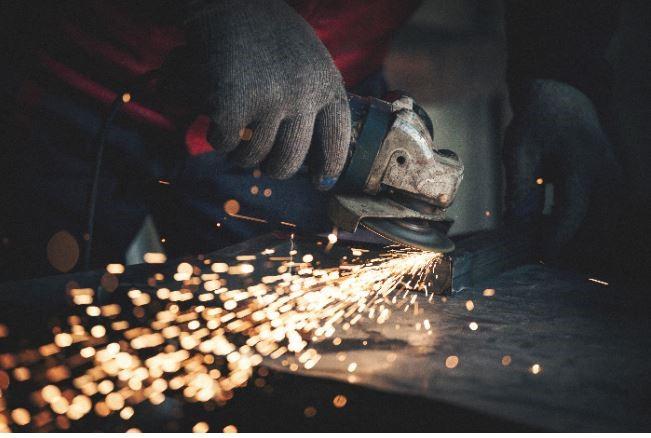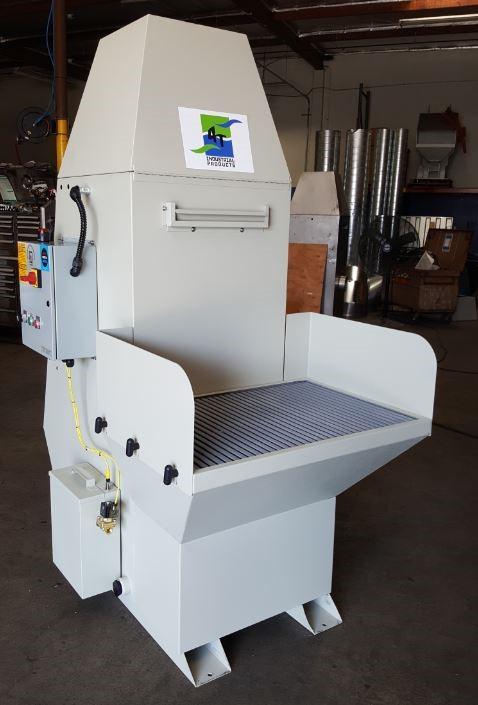Owner
- FMA
- The Fabricator
- FABTECH
- Canadian Metalworking
Categories
- Additive Manufacturing
- Aluminum Welding
- Arc Welding
- Assembly and Joining
- Automation and Robotics
- Bending and Forming
- Consumables
- Cutting and Weld Prep
- Electric Vehicles
- En Español
- Finishing
- Hydroforming
- Laser Cutting
- Laser Welding
- Machining
- Manufacturing Software
- Materials Handling
- Metals/Materials
- Oxyfuel Cutting
- Plasma Cutting
- Power Tools
- Punching and Other Holemaking
- Roll Forming
- Safety
- Sawing
- Shearing
- Shop Management
- Testing and Measuring
- Tube and Pipe Fabrication
- Tube and Pipe Production
- Waterjet Cutting
Industry Directory
Webcasts
Podcasts
FAB 40
Advertise
Subscribe
Account Login
Search
Combating the hazards of combustible metal dust
The right equipment, testing, and training can keep shops and workers safe
- By Denise Duncan and Jack Rubinger
- October 23, 2020
- Article
- Safety

The dust generated during grinding has the potential to be dangerous, from creating a slipping hazard to possibly contributing to a combustible metal dust fire and explosion. To avoid the latter, metal fabricators should look at equipment that is designed to keep a dust-related catastrophe from occurring. Getty Images.
Even if you have never had a fire from combustible metal dust in your facility, are you fully aware of the dangers and costs involved with such an incident?
It doesn’t take much to ignite a combustible metal dust. Many facilities struggle with fugitive dust and the laundry list of challenges it presents. Regardless of the type, fugitive dust settling on floors, equipment, ducting, surfaces, parts, and raw materials is a safety hazard.
Unfortunately, combustible metal dust fires and explosions haven’t been high on the list of industrial safety problems that need solving, despite their regular occurrence.
Explosions Happen
In one case, workers at a facility in Southern California were using hand tools to polish aluminum rims. Although the workers wore N95 masks, the shop had no ventilation or dust collection system, and aluminum dust literally hung in the air and covered their faces and clothing. After a buildup of many years, the company suffered an aluminum dust explosion that resulted in several workers being injured and severely burned.
At another company, a worker used a shop vac with a little water left in it to vacuum up aluminum dust on a Friday afternoon. The shop vac was left over the weekend. The worker came in Monday morning, turned the shop vac on, and it exploded. The water and aluminum dust mixture generated hydrogen gas. The spark generated by turning on the motor caused the explosion.
And these are just two specific examples. How many combustible metal dust fires take place every day throughout the county that aren’t reported because they were controlled and extinguished without requiring a visit from the local fire department?
The Dust Dilemma
As shown, a shop vac isn’t the right equipment to use with combustible metal dust. You need a vacuum that is certified for use with combustible dust.
In fact, any dust under the right conditions is ignitable and potentially explosive. Different types of dust require different housekeeping procedures, dust collection equipment, storage, and handling. For instance, combustible metal dust such as aluminum, magnesium, and titanium requires different dust collection equipment, extinguishing agents, and housekeeping procedures and protocols than wood dust, yet both are highly ignitable.
“We employ a wet dust collector for our graining operations. We have separate self-contained dust abatement systems for both ferrous and nonferrous materials that are clearly marked and color coded, in addition to the use of downdraft tables for grinding and deburr operation,” said Tony Varela of Metal Fab Inc., Portland, Ore.
Addressing the Dangers
As new manufacturing technologies emerge, so do dust mitigation challenges. 3D printing frequently uses powered metals like aluminum, titanium, and magnesium, which introduce a whole new level of combustible metal dust handling, collection, and safety concerns to an already complex topic.

This wet downdraft table from A T Industrial Products is an example of equipment that is able to collect combustible metal dust that is generated from activities such as deburring, cutting, and grinding.
Now these growing dangers are being addressed. As of September 2020 facilities are encouraged to have a dust hazards analysis (DHA) performed per NFPA 652, Standard on the Fundamentals of Combustible Dust, Chapter 7. Although NFPA standards are guidelines and not law state agencies, inspectors, consultants, and insurance companies reference them. In fact, insurance companies are far less likely to honor a claim from a shop that does not have practices and equipment as specified in NFPA standards.
A DHA identifies the potential fire and explosion properties of the dust in a shop. Each type of dust, from sanding, grinding, polishing, cutting, and sawing different metals and substrates, should be sampled and tested.
Trade organizations such as the Chemical Safety Board and OHSA can be useful resources for guidance on safety procedures and worker training. Industry consultants are available who specialize in all things related to combustible dust. Industry leaders and specialists offer virtual conferences, podcasts, and You Tube videos that address combustible dust safety, worker training, and equipment.
In addition, colleagues in the industry can be a great source of information about the type of dust collection equipment they use, their housekeeping procedures, and the worker safety training they’ve implemented.
Finally, posting the current NFPA 652, Standard on the Fundamentals of Combustible Dust and NFPA 484, Standard for Combustible Metals ensures all employees have a chance to read and familiarize themselves with the standards’ requirements. These standards are updated every several years to reflect new technologies, requirements, federal laws, and lessons learned, and they’re invaluable guides to keep on-hand.
The Cost of Compliance
What is the cost of combustible dust mitigation, including the testing and equipment required to comply with these standards? Equipment can range from $3,000 for a small industrial vac to several thousands for large wet dust collectors, central vacuum systems, wet downdraft tables, and wet dust booths.
But keep in mind the potential costs of not being in compliance:
- What are the liability costs of worker injuries?
- Will any injuries temporarily or permanently displace valuable workers?
- What is the cost of equipment lost to fire or explosion?
- What is the cost of lost production to your customer?
- Will the insurance company cover all losses?
- Will insurances rates increase?
There’s no wrong time to take even small steps to address combustible metal dust challenges. Everything doesn’t have to be completed at once, and every effort in mitigation increases safety for the shop and its employees.
About the Authors
Denise Duncan
3633 Pomona Blvd.
Pomona, CA 91768
909-593-8340
Related Companies
subscribe now

The Fabricator is North America's leading magazine for the metal forming and fabricating industry. The magazine delivers the news, technical articles, and case histories that enable fabricators to do their jobs more efficiently. The Fabricator has served the industry since 1970.
start your free subscription- Stay connected from anywhere

Easily access valuable industry resources now with full access to the digital edition of The Fabricator.

Easily access valuable industry resources now with full access to the digital edition of The Welder.

Easily access valuable industry resources now with full access to the digital edition of The Tube and Pipe Journal.
- Podcasting
- Podcast:
- The Fabricator Podcast
- Published:
- 04/16/2024
- Running Time:
- 63:29
In this episode of The Fabricator Podcast, Caleb Chamberlain, co-founder and CEO of OSH Cut, discusses his company’s...
- Industry Events
16th Annual Safety Conference
- April 30 - May 1, 2024
- Elgin,
Pipe and Tube Conference
- May 21 - 22, 2024
- Omaha, NE
World-Class Roll Forming Workshop
- June 5 - 6, 2024
- Louisville, KY
Advanced Laser Application Workshop
- June 25 - 27, 2024
- Novi, MI































